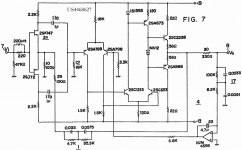Hi Nuvistor,
In practice the Ccomp could probably be reduced by 5 times giving a 10V/us slew rate FOR THE FIRST STAGE. This would be comparable with that of the chip.
Zinsula,
I'm sure the 2SK170 would be fine at 2mA (your comparison compares a 2SK369 at 3mA with the 2SK170 at 1mA) once Fletcher Munson and resistor noise is added. Still an order of magnitude below surface noise.
Cheers,
Greg
In practice the Ccomp could probably be reduced by 5 times giving a 10V/us slew rate FOR THE FIRST STAGE. This would be comparable with that of the chip.
Zinsula,
I'm sure the 2SK170 would be fine at 2mA (your comparison compares a 2SK369 at 3mA with the 2SK170 at 1mA) once Fletcher Munson and resistor noise is added. Still an order of magnitude below surface noise.
Cheers,
Greg
Hi ampguru -
I've done some LTspice simulation of your discrete + opamp circuit with 2sk369 and NE5534 models, acknowledgement to Uwe Beis for the NE5534. I tried flat gains of 5 and 50, Rf=1k, corresponding to RIAA MM and MC gain beyond 50kHz.
With your compensation values I had no success with stable feedback at gains of 5 or 50.
With Miller-integrator compensation of 20pF around the op amp with 5534 Cc=22pF I had success at 50 but not at 5. Avol is 130dB at 20Hz, 77dB at 20kHz, 33dB at 2.4MHz with phase margin of 45°. Perhaps some combination of input lag and Miller compensation could work at 5.
The 2sk369 drain capacitance affects stability, I cascoded with 2N4392, without cascoding 45° pm is at 50dB, 300kHz.
All of this reinforces my opinion that amplifiers with 3 gain stages are difficult to compensate simply at low closed-loop gains.
I've done some LTspice simulation of your discrete + opamp circuit with 2sk369 and NE5534 models, acknowledgement to Uwe Beis for the NE5534. I tried flat gains of 5 and 50, Rf=1k, corresponding to RIAA MM and MC gain beyond 50kHz.
With your compensation values I had no success with stable feedback at gains of 5 or 50.
With Miller-integrator compensation of 20pF around the op amp with 5534 Cc=22pF I had success at 50 but not at 5. Avol is 130dB at 20Hz, 77dB at 20kHz, 33dB at 2.4MHz with phase margin of 45°. Perhaps some combination of input lag and Miller compensation could work at 5.
The 2sk369 drain capacitance affects stability, I cascoded with 2N4392, without cascoding 45° pm is at 50dB, 300kHz.
All of this reinforces my opinion that amplifiers with 3 gain stages are difficult to compensate simply at low closed-loop gains.
2SK146 availability
FYI, I just had a reply to an inquiry about 2SK146's:
"thank you for your enquiry via www.mark5.com.
We are pleased to quote:-
6 min x 2SK146 at £11.37 each
Delivery from Australia by Air Parcel Post at £15.44 10 days approx"
Expensive, but maybe ok if a group of folk get together to purchase?
FYI, I just had a reply to an inquiry about 2SK146's:
"thank you for your enquiry via www.mark5.com.
We are pleased to quote:-
6 min x 2SK146 at £11.37 each
Delivery from Australia by Air Parcel Post at £15.44 10 days approx"
Expensive, but maybe ok if a group of folk get together to purchase?
if you follow the link to my web page below, here is an article on RIAA preamps and a spread sheet to calculate the equalization network using the Lipshitz equations.
It is fun to build using discrete components, but value for money and performance probably favors an op-amp approach.
Note that in the Baxandall circuit I discuss, you should use a buffer after the 2dary post filter - something AndrewT raised and that I will attend to when I write part 2. Right now though I am up to my eyeballs in my next power amp. ;-)
RIAA Phono Equalizer, phono amplifier | hifisonix.com
It is fun to build using discrete components, but value for money and performance probably favors an op-amp approach.
Note that in the Baxandall circuit I discuss, you should use a buffer after the 2dary post filter - something AndrewT raised and that I will attend to when I write part 2. Right now though I am up to my eyeballs in my next power amp. ;-)
RIAA Phono Equalizer, phono amplifier | hifisonix.com
unfortunately several URLs are death in the meantime.
By the article under
http://www.analog.com/media/en/technical-documentation/application-notes/5866763300941AN245.pdf
I have found by the references follow paper:
"Topology considerations for RIAA Phono preamplifiers" (W.Jung)
Who can upload this report ?
Thank you very much.
By the article under
http://www.analog.com/media/en/technical-documentation/application-notes/5866763300941AN245.pdf
I have found by the references follow paper:
"Topology considerations for RIAA Phono preamplifiers" (W.Jung)
Who can upload this report ?
Thank you very much.
- Status
- Not open for further replies.
- Home
- Amplifiers
- Solid State
- Good Phono preamp circuit?
